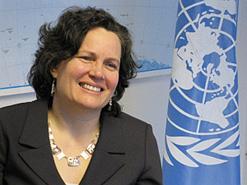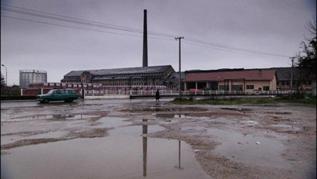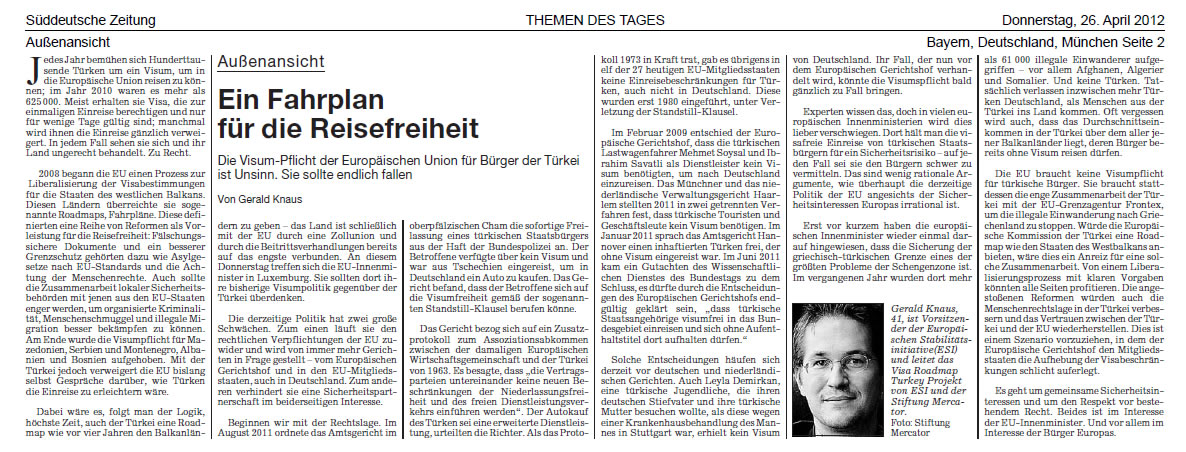

Kori Udovicki (UNDP) – Declining industries in Leskovac
Media reactions to this appeal:
- USA TODAY, Melanie Sevcenko and Jacob Resneck, “Alienated voters may divert Serbia from West-friendly rule” (6 May 2012)
- Arab News, “Small signs of hope for Serb textile hub” (5 May 2012)
- Reuters, Aleksandar Vasovic, “Devastated textile town offers lessons for Serbia” (3 May 2012)
- Transitions Online, S. Adam Cardais, “The Balkan Jobs Crisis” (19 April 2012)
- PenzaNews, “Зарубежные аналитики заявляют о неизбежности экономических реформ в странах Западных Балкан” (“Foreign analysts argue that economic reforms in Western Balkan countries are inevitable”) (19 April 2012)
- Balkans.com Business News, “Mass unemployment in the Western Balkans” (17 April 2012)
- EMG, “EU Observer:Mass unemployment in the Balkans – a need to act” (16 April 2012)
- Economy poslovni portal, “Zabrinjavajuća masovna nezaposlenost na Balkanu”(“Disturbing mass unemployment in the Balkans”) (16 April 2012)
- Capital, “EUObserver: Balcanii de Vest nu mai pot continua actualul curs economic”(“EUobserver: Western Balkans cannot continue the current economic policy”) (13 April 2012)
- EUobserver, Kori Udovicki and Gerald Knaus, “Mass unemployment in the Balkans – a need to act” (12 April 2012)
Kori Udovicki, a former Governor of the National Bank of Serbia and former Minister of Energy, who had worked as an economist for the IMF and had set up and run an economic think tank in Belgrade, has since 2007 been Assistant Secretary-General and Assistant Administrator of UNDP responsible for Europe and the Commonwealth of Independent States (CIS). We met a few times in recent months to discuss economic development issues in the Balkans: in New York, in Paris and most recently in Bruges. As we talked we quickly discovered that we shared a very similar approach to these issues, even though we looked at them from different perspectives and experiences.
As Kori told me, after a long career as a macroeconomist, with a PhD in economics from Yale under her belt, she had grown increasingly sceptical about the conventional economic policy advise that had been offered to Balkan countries in recent years. It is not that this advise is not sound, but that it is dangerously limited. Yes, macroeconomic stability is important, crucial even. Yes, privatisation and indeed liquidation of loss making companies was needed (and indeed often took much too long in the Balkans). And yes, it cannot harm if it is easier and quicker to register a new business. But these prescriptions alone will not be enough to create the jobs and reverse a disastrous process of deindustrialisation from which the Balkan region has suffered in the past two decades.
I had long felt the same, and this sense of unease was recently reinforced after a conference debating economic policy in the region in the wake of the global financial crisis organised by the Central Bank of Greece in Athens. There, in the presence of governors of Central Banks from across South East Europe, numerous speakers pointed out the need to rethink the current growth model in the region. They warned that what had happened in recent years, consumer credit driven growth, was not going to work in the future. And yet, there remained a vagueness in the debate about an alternative and yet credible approach to growth.
And so Kori and myself put our heads together, debated, discussed and sent drafts across the atlantic to produce something we called an “appeal” concerning the employment crisis in the Balkans. This text benefitted hugely from debates with and research undertaken by my ESI colleagues, in this case in particular Kristof Bender and Eggert Hardten. It also benefitted from feedback at a seminar at the College d’Europe recently in Bruges, where I had been invited to present ideas to the senior staff of UNDP working in South East Europe. Above all it benefitted from the long debates, continued over skype, with Kori.
We certainly hope that this will be a useful and provocative small contribution to an inportant topic; one that concerns arguably the biggest structural threat to a lasting stabilisation of the Balkans.
The Balkan Employment Crisis—an urgent appeal
(Oped by Kori Udovicki and Gerald Knaus)
Leskovac, once known as the Serbian Manchester, is home to a textile industry that began in the 19th century, flourished under communism, and survives – albeit barely – till today. The town, which lies in the south of Serbia, boasts a textile school (set up in 1947), an association of textile engineers, and its very own textile magazine. The boom years are a distant memory, however. Leskovac’s socialist-era companies are bankrupt, their production halls empty, their machines dismantled and sold as scrap metal.
In the past two decades Leskovac has seen its population decline from 162,000 (1991) to less than 140,000. The drop in the working-age population has been disproportionately
high, and unemployment has increased. At the heart of the town’s plight, and that of so many other regions in the Western Balkans, is the impact of dramatic de-industrialization.
Contemporary Serbia is a society whose population is both aging (with an average age of 41, it is one of the oldest in the world) and shrinking. So is its industry. A recent article in the local press cites that 98 large, complex, industrial companies have shut down over the past two decades. And, most worrisomely, so is total employment. After stagnating throughout the economic recovery of the 2000s, it has been sharply declining since 2008. Today the employment rate is down to about 45 per cent, more than 20 per cent below the EU average. Half of the young are unemployed. In the textile and clothing sector, the number of workers has collapsed from 160,000 in 1990 to around 40,000 in 2010.
Serbia’s textile industry is representative of much of its industry, and Serbia’s labor market trends are representative of those in all the post-Yugoslav states. The employment rate in Albania is also one of the lowest in Europe.
It is true that Europe’s textile industry has been put on the defensive by the emerging Far East. However, it would be wrong to conclude that Serbia’s textile industry’s decline has been inevitable. In recent decades, the sector – one of the most highly globalized in the world – has seen employment shift from Germany to Poland, from Hong Kong to China, from Italy to Hungary and Turkey, and then to Bulgaria and Romania. In many peripheral regions across South East Europe, textiles have been a recent locomotive of growth and exports, creating hundreds of thousands of low-skilled jobs. The question we need to ask is why so few of these jobs have found their way to the Western Balkans. Bulgaria was able to increase its exports in the textile and clothing sector from 280 million USD to more than 2 billion US between 1990 and 2010, contributing more than 100,000 industrial jobs. Why hasn’t this been possible in Serbia, Bosnia or Albania? The same questions could be asked about other industries in the Balkans. Why are there more than 10,000 jobs in the furniture industry in the Central Anatolian city of Kayseri, far from any woods, but not in Bosnia and Herzegovina? Why are household appliance producers doing well in Slovenia, Western Romania and Western Anatolia, but not in the Western Balkans? How about agro-processing for the EU market? And what about Bosnia’s armaments industry, the mainstay of its industry in the past? Was its collapse really inevitable?
One answer is that the growth model adopted in the Western Balkans over the last decade has discouraged governments from asking such specific questions. Driven by distrust of the legacy of socialist planning, as well as by fear of state capture by corrupt businesses and corruption in the administration, the preferred economic policies have been hands-off, focusing not on specific sectors of the economy but on the general business environment. Policymakers have been praised for avoiding the temptation to shield declining areas of the economy from the discipline of the market. At the same time they found it hard to acknowledge when many former socialist businesses were past the point of possible recovery, overburdened by their debts and in urgent need of liquidation. Neither the political debates nor the legal framework in the region acknowledged that liquidation, sometimes, is the best way to ensure that existing resources—people and capital—remain in use, by being re-employed in the new growing private sector.
These key ingredients of the standard recipes of economic policy in the past decade are important, of course: a stable macroeconomic environment and a good business climate, in
which it is easier to open and close businesses, are a necessary condition for sustained recovery. But they are not sufficient. In a region ravaged by conflict and the sheer length of economic decline, a policy mix of “hands-off”, “rules-based” privatization and deregulation cannot be sufficient to launch sustained economic recovery. Even during the periods of relative economic growth and high FDI inflows, the employment generated by the new, entrepreneurial private sector was not sufficient to offset the jobs shed by the slowly restructuring and privatized old industries. The financial crisis of 2008 has wiped out more than the jobs generated in the recovery period, even if informal job generation is taken into
account.
While the recovery lasted, there was a hope that FDI would yet accelerate and begin to generate more employment. Now, however, it is clear that the growth model needs to be changed. This has been noted by international institutions, most explicitly the European Bank for Reconstruction and Development (EBRD). More importantly, regional policymakers, under increasing pressure to generate jobs, have begun reaching for desperate measures, such as large, blanket, subsidies for foreign investors. This is the kind of step that has so often in the past given industrial policy a bad name.
What would an alternative model of economic growth look like? In answering this question, it helps to keep in mind that there is not, in fact, one simple answer. Each time, the answer depends on the context. Clearly, the key is the inclusion into global chains of industrial production. Credible industrial policies are needed to define ways of encouraging the mobile global investments to those sectors – from food processing to clothing, from furniture to basic engineering assembly – where declining industrial regions in the Balkans possess a comparative advantage. For this one needs a better understanding of the drivers behind the industrial jobs that are already being generated. In Leskovac, for example, over the past five years new jobs have been linked to investments by companies from Germany, South Korea and Turkey.
The question then becomes: what could be done to turn the trickle into a flood? Comparative advantages are likely to be still hiding in the remnants of the past. Declining industries have left behind redundant workers and educational institutions without the skills and resources needed to adjust to a new marketplace. Provincial cities like Leskovac lack foreign contacts. However, the right initiatives and support can deliver the necessary resources at a fraction of the costs that it would take to create a conducive environment “from scratch”.
A competent industrial development agency, modelled, for example, on the Irish Industrial Development Agency (IRA) could do this job. The key word here is “competent”. It would have to be able to offer support and advice – based on credible and painstaking sectoral analysis – to local administrations and companies. It would need to help educate local governments about ways of attracting investors. It could also offer grants for private sector management training, to enable their companies to move up the value chain in
different sectors of production.
This is not an easy task. However, there is no reason to assume that such competence in the Western Balkans could not be put together and built up. For this, however, it is necessary, that a new philosophy for the role of industrial policy in economic growth be embraced. This can only be done by the policymakers and governments of the countries themselves.
The EU could also help, however. All too often in the past two decades, the message coming across from EU officials and international financial institutions has, instead, been one of blanket discouragement of government intervention. The EU could do more to support the countries’ ability to develop and pursue credible multiyear strategies in a whole range of sectors, including agriculture and rural development, transportation, environment, and regional development. During the last enlargement wave, each candidate country integrated such strategies into a National Development Plan (NDP), which functioned both as a national roadmap and as a programming document for EU assistance. Such an approach would benefit the countries of the Western Balkans, where the public sector suffers from a dearth of planning capacity and resources for policy development.
Last but not least, the credibility of Western Balkan integration into the EU market could be enhanced. For the Western Balkans, the last few years have seen agonizingly slow progress in this area, with no country other than Croatia having so much as opened EU accession talks. The more realistic the perspective of EU membership for countries such as Serbia or Albania, the bigger the incentives for those interested in long-term investments in industrial production in the Balkans.
Integration with the EU market will be a critical anchor for economic development in the Balkans, but it will take more to ensure convergence. The example of Greece shows that
integration and access to funds is not enough. Greece is currently not able to absorb more than a third of EU structural and cohesion policy funding, because it has never benefited from the massive capacity-building and institutional support that has been given to the Fifth enlargement countries and Croatia. Looking on to the Western Balkan batch, the EU may consider increasing this support, emphasizing the administrative capacity for medium-term development in policy planning and coordination. Bringing development planning
into an earlier stage of the current accession process would allow each Balkan country to focus on the assessment of its competitiveness in agriculture and industry, and learn about the constraints to development faced by these sectors.
None of this is to suggest that there is a silver bullet for job creation. The Balkan development challenge is enormous, and there are deep structural reasons behind the staggeringly low rates of employment in the region – some reaching back into the 1980s and the very nature of socialist industrialisation. Reversing the long-term trend of employment decline is a generational project, made all the more difficult by the current cyclical conditions in Europe. But reindustrialisation has taken place in recent years in a number of new member states or candidates, from Poland to Slovakia. Numerous industrial development clusters – from Timisoara in Western Romania to the Istanbul region and many Anatolian tiger cities in Turkey – have seen growth and success. In all these cases, political elites at the national and local level have made the integration of local businesses into global chains of industrial production a strategic priority.
The lack of employment opportunities today in the Western Balkans is generating quiet despair, especially among the young. Without radical change, without a serious and visible commitment to a new set of policies, the sense if despair now palpable in the region may become burning. There is, in fact, no greater, more urgent, social and economic issue in the Balkans. Fortunately, experiences of successful industrial recoveries and turnarounds abound. Learning from them could turn around the fate of people in Leskovac, and countless other towns just like it.



